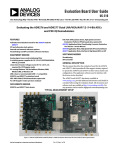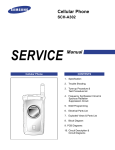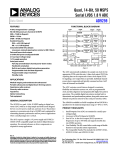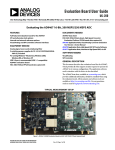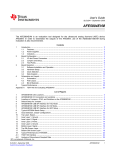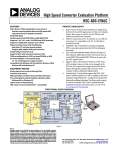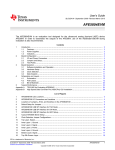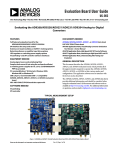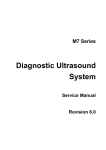Download Analog Devices AD9272 User's Manual
Transcript
Evaluation Board User Guide UG-001 One Technology Way • P.O. Box 9106 • Norwood, MA 02062-9106, U.S.A. • Tel: 781.329.4700 • Fax: 781.461.3113 • www.analog.com Evaluating the AD9272/AD9273 for Ultrasound Systems FEATURES DOCUMENTS NEEDED Full featured evaluation board for the AD9272/AD9273 SPI and alternate clock options Internal and external reference options VisualAnalog and SPI Controller software interfaces AD9272 and AD9273 data sheets HSC-ADC-EVALCZ data sheet, High Speed Converter Evaluation Platform (FPGA-based data capture kit) AN-905 Application Note, VisualAnalog Converter Evaluation Tool Version 1.0 User Manual AN-878 Application Note, High Speed ADC SPI Control Software AN-877 Application Note, Interface to High Speed ADCs via SPI EQUIPMENT NEEDED Analog signal source and antialiasing filter 2 switching power supplies (6.0 V, 2.5 A) CUI EPS060250UHPHP-SZ, provided Linear bench top dc voltage source (0 V to 1.6 V), not required for CW Doppler mode PC running Windows 98 (2nd ed.), Windows 2000, Windows ME, or Windows XP USB 2.0 port, recommended (USB 1.1 compatible) AD9272/AD9273 evaluation board HSC-ADC-EVALCZ FPGA-based data capture kit For CW Doppler mode: spectrum analyzer For CW Doppler mode: dc voltage source: +5 V w/100 mA each SOFTWARE NEEDED VisualAnalog SPI Controller GENERAL DESCRIPTION This document describes the AD9272/AD9273 evaluation board, which provides all of the support circuitry required to operate the AD9272/AD9273 in their various modes and configurations. The application software used to interface with the devices is also described. The AD9272/AD9273 data sheet, available at www.analog.com, provides additional information and should be consulted when using the evaluation board. All documents and software tools are available at http://www.analog.com/fifo. For any questions, send an email to [email protected]. 07782-001 TYPICAL MEASUREMENT SETUP Figure 1. AD9272-65EBZ/AD9272-80KITZ/AD9273-50EBZ Evaluation Board and HSC-ADC-EVALCZ Data Capture Board Please see the last page for an important warning and disclaimers. Rev. 0 | Page 1 of 24 UG-001 Evaluation Board User Guide TABLE OF CONTENTS Features .............................................................................................. 1 Default Operation and Jumper Selection Settings ....................5 Equipment Needed ........................................................................... 1 Evaluation Board Software Quick Start Procedures .....................7 Documents Needed .......................................................................... 1 Configuring the Board .................................................................7 Software Needed ............................................................................... 1 Using the Software for Testing.....................................................7 General Description ......................................................................... 1 Typical Measurement Setup ............................................................ 1 Using the Integrated Crosspoint Switch (CW Doppler Mode) ................................................................. 10 Revision History ............................................................................... 2 Evaluation Board Schematics and Artwork ................................ 12 Evaluation Board Hardware ............................................................ 3 Ordering Information .................................................................... 23 Power Supplies .............................................................................. 3 Bill of Materials ........................................................................... 23 Input Signals .................................................................................. 3 ESD Caution .................................................................................... 24 Output Signals............................................................................... 3 REVISION HISTORY 2/09—Revision 0: Initial Version Rev. 0 | Page 2 of 24 Evaluation Board User Guide UG-001 EVALUATION BOARD HARDWARE The AD9272/AD9273 evaluation board provides all of the support circuitry required to operate the AD9272/AD9273 in its various modes and configurations. Figure 2 shows the typical bench characterization setup used to evaluate the ac performance of the AD9272/AD9273. It is critical that the signal sources used for the analog input and clock have very low phase noise (<1 ps rms jitter) to realize the optimum performance of the signal chain. Proper filtering of the analog input signal to remove harmonics and lower the integrated or broadband noise at the input is necessary to achieve the specified noise performance (see the AD9272 or AD9273 data sheet). evaluation board using the SPI and alternate clock options, a separate 3.3 V analog supply is needed in addition to the other supplies. The 3.3 V supply, or AVDD_3P3V, should have a 1 A current capability. See the Evaluation Board Software Quick Start Procedures section to get started and Figure 21 to Figure 31 for the complete schematics and layout diagrams that demonstrate the routing and grounding techniques that should be applied at the system level. When connecting the clock and analog source, use clean signal generators with low phase noise, such as Rohde & Schwarz SMA or HP8644B signal generators or the equivalent. Use a 1 m, shielded, RG-58, 50 Ω coaxial cable for making connections to the evaluation board. Enter the desired frequency and amplitude (refer to the specifications in the AD9272 or AD9273 data sheet). The evaluation board is set up to be clocked from the crystal oscillator, OSC401. POWER SUPPLIES This evaluation board comes with a wall-mountable switching power supply that provides a 6 V, 2 A maximum output. Connect the supply to the rated 100 V ac to 240 V ac wall outlet at 47 Hz to 63 Hz. The other end is a 2.1 mm inner diameter jack that connects to the PCB at P701. Once on the PC board, the 6 V supply is fused and conditioned before connecting to low dropout linear regulators that supply the proper bias to each of the various sections on the board. When operating the evaluation board in a nondefault condition, L705, L706, L707, and L709 can be removed to disconnect the switching power supply. This enables the user to bias each section of the board individually. Use P602 and P603 to connect a different supply for each section. At least one 1.8 V supply is needed with a 1 A current capability for AVDD_DUT and DRVDD_DUT; however, it is recommended that separate supplies be used for both analog and digital domains. An additional supply is also required to supply 3.0 V to the device under test, AVDD2_DUT. This should also have a 1A current capability. To operate the To bias the crosspoint switch circuitry or CW section and differential gain drive circuitry, separate +5 V and −5 V supplies are required at P601. These should each have 1 A current capability. This section cannot be biased from a 6 V, 2 A wall supply. Separate supplies are required at P601. INPUT SIGNALS If a different or external clock source is desired, follow the instructions Clock Circuitry section. Typically, most Analog Devices evaluation boards can accept ~2.8 V p-p or 13 dBm sine wave input for the clock. When connecting the analog input source, it is recommended to use a multipole, narrow-band band-pass filter with 50 Ω terminations. Analog Devices uses TTE and K&L Microwave, Inc., band-pass filters. The filter should be connected directly to the evaluation board. OUTPUT SIGNALS The default setup uses the FIFO5 high speed, dual-channel FIFO data capture board (HSC-ADC-EVALCZ). Two of the eight channels can then be evaluated at the same time. For more information on channel settings on these boards and their optional settings, visit www.analog.com/FIFO. Rev. 0 | Page 3 of 24 UG-001 Evaluation Board User Guide WALL OUTLET 100V TO 240V AC 47Hz TO 63Hz SWITCHING POWER SUPPLY SWITCHING POWER SUPPLY 6V DC 2A MAX SIGNAL SYNTHESIZER 6V DC 2A MAX ANALOG INPUT SPECTRUM ANALYZER CW OUTPUT SIGNAL SYNTHESIZER OPTIONAL CLOCK SOURCE GAIN CONTROL INPUT Figure 2. Evaluation Board Connection Rev. 0 | Page 4 of 24 07782-070 PC RUNNING ADC ANALYZER OR VISUAL ANALOG USER SOFTWARE AGILENT POWER SUPPLY Evaluation Board User Guide UG-001 PDWN DEFAULT OPERATION AND JUMPER SELECTION SETTINGS This section explains the default and optional settings or modes allowed on the AD9272/AD9273 Rev. A evaluation board. Power Circuitry Connect the switching power supply that is supplied in the evaluation kit between a rated 100 V ac to 240 V ac wall outlet at 47 Hz to 63 Hz and P701. Analog Input Front-End Circuit The evaluation board is set up for a transformer-coupled analog input with an optimum 50 Ω impedance match of 18 MHz of bandwidth. For a different bandwidth response, use the antialiasing filter settings. VREF VREF is set to 1.0 V. This causes the ADC to operate with the internal reference in the 2.0 V p-p full-scale range. A separate external reference option using the ADR130 is also included on the evaluation board. Populate R311 with a 0 Ω resistor and remove C426. Note that ADC full-scale ranges less than 2.0 V p-p are not supported by the AD9272/AD9273. RBIAS RBIAS has a default setting of 10 kΩ (R301) to ground and is used to set the ADC core bias current. However, note that using other than a 10 kΩ, 1% resistor for RBIAS may degrade the performance of the device, depending on the resistor chosen. Clock Circuitry To enable the power-down feature, short P303 to the on position (AVDD) on the PDWN pin. STBY To enable the standby feature, short P302 to the on position (AVDD) on the STBY pin. GAIN+, GAIN− To change the VGA attenuation, drive the GAIN+ pin from 0 V to 1.6 V on J302 using a linear supply and use a single-ended method to change the VGA gain from 0 dB to 42 dB. U403 is available for users who wish to drive the gain pins (GAIN±) differentially. Install R305, R347, and R349 and remove C308, C309, and R303 to connect the amplifier correctly. Next, apply a dc voltage source to P601, connecting the +5 V, −5 V, and ground (0 V) appropriately to bias U403 (AD8138). These benchtop linear supplies should each have 100 mA of current capability. If an external source is not available, R337 can be installed to use the on-board resistive divider for gain adjustment in either the single-ended or differential case. Non-SPI Mode For users who wish to operate the DUT without using SPI, remove the jumpers on J601. This disconnects the CSB, SCLK, and SDIO pins from the control bus, allowing the DUT to operate in its simplest mode. Each of these pins has internal termination and will float to its respective level. Note that the device will only work in its default condition. CWDx+, CWDx− The default clock input circuitry is derived from a simple transformer-coupled circuit using a high bandwidth 1:1 impedance ratio transformer (T401) that adds a very low amount of jitter to the clock path. The clock input is 50 Ω terminated and ac-coupled to handle single-ended sine wave types of inputs. The transformer converts the single-ended input to a differential signal that is clipped before entering the ADC clock inputs. The evaluation board is already set up to be clocked from the crystal oscillator, OSC401. This oscillator is a low phase noise oscillator from Valpey Fisher (VFAC3-BHL-50MHz/VFAC3BHL-65MHz/VFAC3-BHL-80MHz). If a different clock source is desired, remove R403, set Jumper J401 to disable the oscillator from running, and connect the external clock source to the SMA connector, P401. A differential LVPECL clock driver can also be used to clock the ADC input using the AD9515 (U401). Populate R406 and R407 with 0 Ω resistors and remove R415 and R416 to disconnect the default clock path inputs. In addition, populate C405 and C406 with a 0.1 μF capacitor and remove C409 and C410 to disconnect the default clock path outputs. The AD9515 has many pinstrappable options that are set to a default mode of operation. Consult the AD9515 data sheet for more information about these and other options. To use the CWDx± outputs, first apply a dc voltage source to P601, connecting the +5 V, −5 V, and ground (0 V) appropriately to bias U402 (AD812). These benchtop linear supplies should each have 100 mA of current capability. To view the CWD2+/CWD2− through CWD5+/CWD5− outputs, jumper together the appropriate outputs on P606 and P607. All outputs are summed together on the IOP and ION buses, fed to a 1:4 impedance ratio transformer, and buffered so that the user can view the output on a spectrum analyzer. This can be configured to be viewed in single-ended mode (default) or in differential mode by using a spectrum analyzer. To set the voltage for the appropriate number of channels to be summed, change the value of R447 and R448 on the primary transformer (T402). Upon shipment, the CWD0+/CWD0−, CWD1+/CWD1−, CWD6+/CWD6−, and CWD7+/CWD7− outputs are properly biased and ready to use with the AD8339 quad I/Q demodulator and phase shifter. The AD9272/AD9273 evaluation board simply snaps into place on the AD8339 evaluation board (AD8339EVALZ). Remove the jumpers connected to P3A and P4A on the AD8339 evaluation board, and snap the standoffs that are provided with the AD9272/AD9273 into the AD8339 evaluation board standoff holes in the center of the board. The standoffs will automatically lock into place and create a direct connection Rev. 0 | Page 5 of 24 UG-001 Evaluation Board User Guide between the AD9272/AD9273 CWDx± outputs and the AD8339 inputs. DOUTx+, DOUTx− If an alternative data capture method to the setup described in Figure 2 is used, optional receiver terminations, R701 to R710, can be installed next to the high speed backplane connector. Rev. 0 | Page 6 of 24 Evaluation Board User Guide UG-001 EVALUATION BOARD SOFTWARE QUICK START PROCEDURES This section provides quick start procedures for using the AD9272/ AD9273 either on the evaluation board or in a system level design. Both the default and optional settings are described. CONFIGURING THE BOARD Before using the software for testing, configure the evaluation board as follows: Connect the evaluation board to the data capture board as shown in Figure 1 and Figure 2. 2. Connect one 6 V, 2.5 A switching power supply (such as the CUI Inc. EPS060250UH-PHP-SZ supplied) to the AD9272/AD9273 board. 3. Connect one 6 V, 2.5 A switching power supply (such as the CUI EPS060250UH-PHP-SZ supplied) to the HSCADC-EVALCZ board. 07782-021 1. Figure 3. VisualAnalog, New Canvas Window 2. 5. On the ADC evaluation board, place jumpers on all four pin pairs of J601 to connect the SPI bus. 6. On the ADC evaluation board, ensure that J401 (OSC_EN) is jumpered to the on setting to use the on-board 50 MHz/ 65 MHz/80 MHz Valpey Fisher VFAC3 oscillator. 7. On the ADC evaluation board, use a clean signal generator with low phase noise to provide an input signal to the desired channel. Use a 1 m, shielded, RG-58, 50 Ω coaxial cable to connect the signal generator. For best results, use a narrow-band band-pass filter with 50 Ω terminations and an appropriate center frequency. (Analog Devices uses TTE, Allen Avionics, and K&L band-pass filters.) USING THE SOFTWARE FOR TESTING If a different program is desired, follow Step 3. Figure 4. VisualAnalog, Default Configuration Message 3. Setting Up the ADC Data Capture Block After configuring the board, set up the ADC data capture block using the following steps: 1. After the template is selected, a message appears, asking if the default configuration can be used to program the FPGA (see Figure 4). Click Yes, and the window closes. 07782-028 Connect the HSC-ADC-EVALCZ board (J6) to the PC with a USB cable. Open VisualAnalog™ on a PC. AD9272 or AD9273 should be listed in the status bar of the New Canvas window. Select the template that corresponds to the type of testing to be performed (see Figure 3). To view different channels or change features to settings other than the default settings, click the Expand Display button. This is located on the bottom right corner of the window, as shown in Figure 5. This process is described in the AN-905 Application Note, VisualAnalog Converter Evaluation Tool Version 1.0 User Manual. After you are finished, click the Collapse Display button (see Figure 6). EXPAND DISPLAY BUTTON Figure 5. VisualAnalog Window Toolbar, Collapsed Display Rev. 0 | Page 7 of 24 07782-022 4. UG-001 Evaluation Board User Guide Setting Up the SPI Controller COLLAPSE DISPLAY BUTTON After the ADC data capture board setup is completed, set up the SPI Controller using the following procedure: SETTINGS BUTTON Open the SPI Controller software by going to the Start menu or double-clicking the SPI Controller software desktop icon. If prompted for a configuration file, select the appropriate one. If not, check the title bar of the window to determine which configuration is loaded. If necessary, choose Cfg Open from the File menu and select the appropriate one. Note that the CHIP ID(1) field should be filled to indicate whether the correct SPI Controller configuration file is loaded or not (see Figure 8). 07782-023 1. Figure 6. VisualAnalog, Main Window Program the HSC-ADC-EVALCZ board’s FPGA to a setting other than the default setting as described in Step 3. Then expand the VisualAnalog display and click the Settings button in the ADC Data Capture block (see Figure 6). The ADC Data Capture Settings box opens (see Figure 7). 07782-016 4. Figure 8. SPI Controller, CHIP ID(1) Box 2. Click the New DUT button in the SPI Controller. 07782-025 NEW DUT BUTTON Figure 7. ADC Data Capture Settings Window, Board Settings Tab Select the Board Settings tab and browse to the appropriate programming file. If you are using an encode rate <28 MSPS, select Octal_Low_Speed.bin. If you are using an encode rate >28 MSPS, select Octal_High_Speed.bin. Next, click Program; the DONE LED in the HSC-ADC-EVALCZ board should then turn on. If more than two channels are required to be displayed, select Octal_High_8-Channel_synchronous Capture.bin. This canvas allows the user to display all the channels at once. The drawback is that each FFT display is only 8k points. 07782-116 5. Exit the ADC Data Capture Settings box by clicking OK. Figure 9. SPI Controller, New DUT Button 3. Rev. 0 | Page 8 of 24 In the Global tab of the SPI Controller, find the CHIP GRADE(2) box. Use the drop-down box to select the correct speed grade, if necessary. See the AD9272 or AD9273 data sheet, the AN-878 Application Note, and the AN-877 Application Note for reference. Evaluation Board User Guide UG-001 In the ADC A tab of SPI Controller, find the OFFSET(10) box. Use the drop-down box labeled Offset Adj to perform an offset correction to the LNA if the LNA power setting BIAS_CURR_A(12) has been set low. The default value is 32. Select 33 if the low LNA power setting BIAS_CURR_A(12) is used. 07782-018 5. 07782-017 Figure 12. SPI Controller, OFFSET(10) Box Figure 10. SPI Controller, CHIP GRADE(2) Box 07782-217 In the ADCBase 0 tab of the SPI Controller, find the HIGHPASS(2B) box. Click Manual Tune to calibrate the antialiasing filter. See the AD9272 or AD9273 data sheet, the AN-878 Application Note, and the AN-877 Application Note for reference. Figure 13. SPI Controller, BIAS_CURR_A(12) Box Click the Run button in the VisualAnalog toolbar. RUN BUTTON Figure 14. VisualAnalog Window Toolbar, Collapsed Display Figure 11. SPI Controller, HIGHPASS(2B) Box Rev. 0 | Page 9 of 24 07782-122 6. 07782-117 4. UG-001 Evaluation Board User Guide 0 Adjusting the Amplitude of the Input Signal fIN = 3.5MHz @ –1dBFS LNA = 6× VGAIN = 1V FILTER TUNED HPF = 700kHz –10 Next, adjust the amplitude of the input signal for each channel as follows: –20 1. –40 –30 AMPLITUDE (dBFS) Adjust the amplitude of the input signal so that the fundamental is at the desired level. (Examine the Fund Power reading in the left panel of the VisualAnalog FFT window.) If the gain pin voltage is too low, it is not possible to reach full scale without distortion. Use a higher gain setting or a lower input level to avoid distortion. This also depends on the PGA gain setting, which can be 30 dB, 27 dB, 24 dB, or 21dB. See Figure 15 and Figure 16. –50 –60 –70 –80 –90 –100 07782-119 –110 –120 –130 0 5 10 15 20 25 FREQUENCY (MHz) Figure 17. Typical FFT, AD9272/AD9273 USING THE INTEGRATED CROSSPOINT SWITCH (CW DOPPLER MODE) 07782-026 To examine the spectrum of the CW Doppler integrated crosspoint switch output, use the following procedure: Complete the steps in the Configuring the Board and Using the Software for Testing sections to ensure that the board is set up correctly. 2. Optionally, remove the voltage source from the gain pin. It does not affect the CW Doppler output. 3. Connect the dc voltage source to P601, connecting the −5 V pin, the 0 V ground pin, and the +5 V pin as shown in Figure 1. These benchtop linear supplies should each have 100 mA of current capability. 4. Place jumpers on the top pin pairs of P606 or P607 to connect CWD2+/CWD2− to CWD5+/CWD5− to the IOP/ION buses. This directs each of these connections to the output amplifier for display. Note that the CWD0±/CWD1±/CWD6±/CWD7± outputs are configured and biased to interface with the AD8339 evaluation board. The AD9272/AD9273 is specially designed to snap onto the AD8339 evaluation board to allow the user to evaluate a larger portion of this common signal chain. For detailed instructions about enabling this function, send an email to [email protected]. 07782-027 Figure 15. VisualAnalog, Graph Window 1. Figure 16. VisualAnalog, Formatted FFT Plot 2. Repeat this procedure for the other seven channels. 3. Click the disk icon within the Graph window to save the performance plot. See Figure 17 for an example. 5. Use a 1 m, shielded, RG-58, 50 Ω coaxial cable to connect the spectrum analyzer to J402 (labeled AOUT on the evaluation board). 6. In the ADCBase 0 tab of the SPI Controller, find the MODES(8) box. Select the CW Mode option (see Figure 18). Rev. 0 | Page 10 of 24 UG-001 07782-030 Evaluation Board User Guide Figure 19. SPI Controller, CROSSPOINT SWITCH(2D) Box 8. Examine the spectrum analyzer for the CW Doppler output (see Figure 20 for an example). 0 –10 FREQUENCY = 2.3MHz CWD1±, DIFFERENTIAL OUTPUT AMPLITUDE (dBm) –20 –30 –40 –50 –60 –70 07782-004 –80 –90 –100 07782-029 0 Figure 18. SPI Controller, MODES(8) Box 7. In the ADC x tab of the SPI Controller, where x is the channel to which an analog input is applied, find the CROSSPOINT SWITCH(2D) box. From the Crosspoint Switch Modes drop-down box, select the cwd2p/n option (see Figure 19). Rev. 0 | Page 11 of 24 5 10 15 20 25 FREQUENCY (MHz) Figure 20. Typical Spectrum Analyzer Display of CWD Output UG-001 Evaluation Board User Guide EVALUATION BOARD SCHEMATICS AND ARTWORK 07782-005 Figure 21. Evaluation Board Schematic, DUT Analog Input Circuits Rev. 0 | Page 12 of 24 Evaluation Board User Guide UG-001 07782-006 Figure 22. Evaluation Board Schematic, DUT Analog Input Circuits (Continued) Rev. 0 | Page 13 of 24 UG-001 Evaluation Board User Guide 07782-007 Figure 23. Evaluation Board Schematic, DUT, VREF, and Decoupling Rev. 0 | Page 14 of 24 Evaluation Board User Guide UG-001 07782-008 Figure 24. Evaluation Board Schematic, Clock, SPI, and Gain Circuits Rev. 0 | Page 15 of 24 UG-001 Evaluation Board User Guide 07782-009 Figure 25. Evaluation Board Schematic, Power Supply, CW Doppler, Digital Output Interface Rev. 0 | Page 16 of 24 UG-001 07782-010 Evaluation Board User Guide Figure 26. Evaluation Board Layout, Top Side Rev. 0 | Page 17 of 24 Evaluation Board User Guide 07782-011 UG-001 Figure 27. Evaluation Board Layout, Ground Plane (Layer 2) Rev. 0 | Page 18 of 24 UG-001 07782-012 Evaluation Board User Guide Figure 28. Evaluation Board Layout, Power Plane (Layer 3) Rev. 0 | Page 19 of 24 Evaluation Board User Guide 07782-013 UG-001 Figure 29. Evaluation Board Layout, Power Plane (Layer 4) Rev. 0 | Page 20 of 24 UG-001 07782-014 Evaluation Board User Guide Figure 30. Evaluation Board Layout, Ground Plane (Layer 5) Rev. 0 | Page 21 of 24 Evaluation Board User Guide 07782-015 UG-001 Figure 31. Evaluation Board Layout, Bottom Side Rev. 0 | Page 22 of 24 Evaluation Board User Guide UG-001 ORDERING INFORMATION BILL OF MATERIALS Table 1. Item 1 Qty 79 2 9 3 4 5 6 7 8 9 6 1 2 1 1 1 8 10 11 12 5 1 1 13 12 14 15 16 17 18 19 20 21 2 3 2 1 1 1 2 8 22 10 23 24 1 11 25 8 26 16 27 28 29 5 6 8 30 13 31 32 33 1 3 1 Reference Designator C101, C102, C106, C110, C111, C115, C120, C121, C125, C130, C131, C136, C201, C202, C206, C210, C211, C215, C220, C221, C225, C230, C231, C236, C301, C302, C304, C305, C306, C307, C308, C309, C401, C402, C403, C404, C409, C410, C412, C413, C414, C415, C416, C419, C420, C421, C422, C423, C425, C502, C504, C601, C602, C706, C708, C710, C712, C730, C731, C732, C733, C734, C735, C740, C742, C743, C744, C745, C749, C750, C751, C752, C753, C754, C755, C756, C770, C771, C2201 C426, C714, C715, C716, C717, C719, C720, C721, C722 C501, C503, C705, C707, C709, C711 C704 C801, C802 C803 CR702 D401 D101, D102, D103, D104, D201, D202, D203, D204 D701, D702, D703, D704, D705 F701 OSC401 J101, J102, J103, J104, J201, J202, J203, J204, J302, J402, J403 ,P401 P302, P303 J601, P606, P607 P604, P605 J401 P601 P701 P702, P703 L401, L402, L403, L404, L405, L406, L407, L408 L501, L502, L702, L703, L704, L705, L706, L707, L708, L709 L701 R425, R427, R429, R431, R433, R435, R436, R439, R441, R443, R445 R107, R121, R136, R151, R207, R221, R236, R251 R102, R116, R131, R146, R202, R216, R231, R246, R403, R405, R415, R416, R417, R418, R451, R452 R303, R346, R348, R422, R423 R319, R325, R326, R601, R602, R603 R301, R338, R401, R402, R410, R604, R605, R606 R101, R115, R130, R145, R201, R215, R230, R245, R302, R404, R411, R455, R458 R335 R340, R341, R343 R342 Description Capacitor, 0.1 μF, 0402, ceramic, X5R, 10 V Manufacturer Panasonic Part Number ECJ-0EB1A104K Capacitor, 1.0 μF, 0603, ceramic, 16 V, X5R Panasonic ECJ-BVB1C105M Capacitor, 10 μF, 0603, ceramic, 6.3 V, 20%, X5R Capacitor, 10 μF, 6032-28, tantalum, SMT, 16 V, 10% Capacitor mono ceramic, 1 μF, 0402, X5R Capacitor ceramic, 100 pF, 0402 LED, 0603, green Diode Schottky GP LN 30 V, 20 mA SOT-23 Diode Schottky GP LN 20 V SOT-23 Panasonic Kemet Murata Panasonic Panasonic Avago Fairchild ECJ-1VB0J106M T491C106K016AT GRM155B30J105KE18D ECJ-0EC1H101J LNJ314G8TRA HSMS-2812-TR1G MMBD4148SE Diode, silicon rectifier, SMBJ, 2 A, 50 V Polyswitch 1.1 A reset fuse SMD CLK oscillator, 3.3 V, 50 MHz/65 MHz/80 MHz Microcommercial Tyco/Raychem Valpey Fisher SMA, end launch, coaxial Samtec S2A-TP NANOSMDC110F-2 VFAC3-BHL-50MHz, VFAC3-BHL-65MHz, VFAC3-BHL-80MHz SMA-J-P-H-ST-EM1 Header, 2-pin, single row, male, 100 mil, straight Conn-PCB header 8-pin double row Conn-PCB header, 8-pin, double row Header, 3-pin, single row, male, 100 mil, straight Terminal block, 4-pin, straight Power supply connector Header Inductor chip coil, 560 μH, 1210 Samtec Samtec Samtec Samtec Weiland Switchcraft Tyco Murata TSW-102-07-G-S TSW-104-07-G-D SSW-104-06-G-D TSW-103-07-G-S Z5.531.3425.0 RAPC722X 6469169-1 LQH32MN561J23L Ferrite chip 50 Ω, 3 A 1206 Murata BLM31PG500SN1L EMI filter LC block choke coil Resistor, thick film, SMT 0201, 0 Ω Murata Panasonic BNX016-01 ERJ-1GE0R00C Resistor, thick film, SMT 0402, 348 Ω, 1/16 W, 1% Panasonic ERJ-2RKF3480X Resistor, thick film, SMT 0402, 0 Ω Panasonic ERJ-2GE0R00X Resistor, thick film, SMT 0402, 100 Ω, 1/16 W, 1% Resistor, thick film, SMT 0402, 1.00 kΩ, 1/16 W, 1% Resistor, thick film, SMT 0402, 10 kΩ, 1/16 W, 1% Panasonic Panasonic Panasonic ERJ-2RKF1000X ERJ-2RKF1001X ERJ-2RKF1002X Resistor, thick film, SMT 0402, 49.9 Ω, 1/16 W, 1% Panasonic ERJ-2RKF49R9X Resistor, thick film, SMT 0402, 8.66 kΩ, 1/16 W, 1% Resistor, thick film, SMT 0402, 499 Ω, 1/16 W, 1% Resistor, thick film, SMT 0402, 523 Ω, 1/16 W, 1% Panasonic Panasonic Panasonic ERJ-2RKF8661X ERJ-2RKF4990X ERJ-2RKF5230X Rev. 0 | Page 23 of 24 UG-001 Evaluation Board User Guide Item 34 35 36 37 38 39 40 41 42 43 44 45 46 47 48 49 Qty 1 1 1 3 2 6 1 1 1 1 1 1 1 1 1 1 Reference Designator R344 R345 R414 R420, R421, R716 R447, R448 R453, R454, R801, R802, R803, R804 R446 R336 T401 T402 U601 U602 U302 U401 U402 U701 50 51 52 53 54 2 1 1 1 1 U704, U707 U705 U706 U403 U301 Description Resistor, thick film, SMT 0402, 33 kΩ, 1/16 W, 1% Resistor, thick film, SMT 0402, 10.5 kΩ, 1/16 W, 1% Resistor, thick film, SMT 0402, 4.12 kΩ, 1/16 W, 1% Resistor, thick film, SMT 0402, 240 Ω, 1/16 W, 5% Resistor, thick film, SMT 0402, 124 Ω, 1/16 W, 1% Resistor, thick film, SMT 0402, 750 Ω, 1/16 W, 1% Resistor, thick film, SMT 0402, 113 Ω, 1/16 W, 1% potentiometer, 10 kΩ square cermet top Transformer, RF, 1:1 Transformer, ADTT4-1, CD542 IC, buffer, UHS dual, OD out, SC70-6 IC, buffer, UHS dual, SC70-6 IC, VREF, precision sub–band gap, 3-lead TSOT IC, clock distribution, 32-lead LFCSP IC, op amp, current feedback, dual, 8-lead SOIC IC high ACC. 500 mA anyCAP® low drop 2.5 V regulator IC, regulator, high accuracy, 1.8 V, SOT-223 IC, regulator, high accuracy, 3.3 V, SOT-223 IC, regulator, high accuracy, 3.0 V, SOT-223 IC, low distortion diff ADC driver, 8-lead SOIC IC, octal LNA/VGA/AAF/ADC and crosspoint switch TQFP-100 (SV-100-3) Manufacturer Panasonic Panasonic Panasonic Panasonic Panasonic Panasonic Panasonic Copal Minicircuits Minicircuits Fairchild Fairchild Analog Devices Analog Devices Analog Devices Analog Devices Part Number ERJ-2RKF3302X ERJ-2RKF1052X ERJ-2RKF4121X ERJ-2GEJ241X ERJ-2RKF1240X ERJ-2RKF7500X ERJ-2RKF1130X CT94EW103 ADT1-1WT+ ADTT4-1+ NC7WZ07P6X NC7WZ16P6X ADR130BUJZ-R2 AD9515BCPZ AD812ARZ ADP3335ACPZ-2.5R7 Analog Devices Analog Devices Analog Devices Analog Devices Analog Devices ADP3339AKCZ-1.8-R7 ADP3339AKCZ-3.3-R7 ADP3339AKCZ-3-RL7 AD8138ARZ AD9273BSVZ-50, AD9272BSVZ-65, AD9272BSVZ-80 ESD CAUTION Evaluation boards are only intended for device evaluation and not for production purposes. Evaluation boards are supplied “as is” and without warranties of any kind, express, implied, or statutory including, but not limited to, any implied warranty of merchantability or fitness for a particular purpose. No license is granted by implication or otherwise under any patents or other intellectual property by application or use of evaluation boards. Information furnished by Analog Devices is believed to be accurate and reliable. However, no responsibility is assumed by Analog Devices for its use, nor for any infringements of patents or other rights of third parties that may result from its use. Analog Devices reserves the right to change devices or specifications at any time without notice. Trademarks and registered trademarks are the property of their respective owners. Evaluation boards are not authorized to be used in life support devices or systems. ©2009 Analog Devices, Inc. All rights reserved. Trademarks and registered trademarks are the property of their respective owners. UG07782-0-2/09(0) Rev. 0 | Page 24 of 24
























